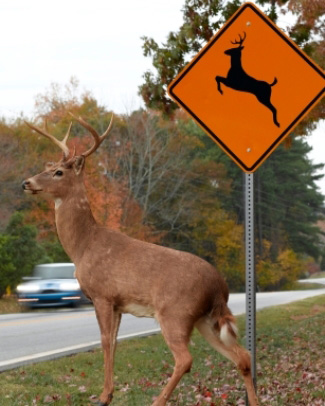How to avoid deer-car collisions
Chris Kissell
You’re driving along a lonely country road when a deer suddenly jumps out in front of the car and you collide. Fortunately, you’re OK – but the deer has been killed, and the car has sustained extensive damage.
Such a scenario probably is more common than you think.
An estimated 1.23 million collisions were caused by the presence of deer in the United States between July 1, 2011, and June 30, 2012, according to a State Farm analysis of claims data and state licensed driver counts from the Federal Highway Administration.
The numbers mark a 7.7 percent increase in such accidents over the previous year, says Dick Luedke, a State Farm spokesman.
“The general trend is more of these collisions over the long period of time, but the increase this year was greater than it has been in most years,” Luedke says.
Deer-car collisions kill about 200 people every year, according to the most recent figures from the Insurance Institute for Highway safety.
They also can be expensive. State Farm reports the average car insurance claim for such crashes was $3,305 for the time period captured in the study. That’s an increase of 4.4 percent from the previous year.
Costs vary depending on the type of vehicle and severity of damage.
Deer danger zones
For the sixth consecutive year, West Virginia was the state where a driver was most likely to collide with a deer, according to the State Farm data. Drivers there have a 1-in-40 chance of colliding with a deer over the next 12 months.
The top five states were:
|
State |
Odds of collision |
|
West Virginia |
1 in 40 |
|
South Dakota |
1 in 68 |
|
Iowa |
1 in 72 |
|
Michigan |
1 in 72 |
|
Pennsylvania |
1 in 76 |
Loretta Worters, a spokeswoman for the nonprofit Insurance Information Institute, says collisions can happen with all types of animals. However, deer-car crackups make up the vast majority of such mishaps.
“Really, 99 percent of the animals (involved) are deer,” she says. “There may be a tiny fraction that could be a moose or other animal.”
Deer-car collisions are a way of life in some states. In 2011, nearly 53,600 deer-car collisions were reported in Michigan, resulting in eight deaths and nearly 1,500 injuries, according to the Michigan Deer Crash Coalition.
Lori Conarton, chairwoman of the coalition and a spokeswoman for the nonprofit Insurance Institute of Michigan, says the number of deer-car crashes in Michigan probably is higher than the official numbers suggest. The coalition has found that as many as half of all such crashes go unreported. Total damages in Michigan are estimated at $130 million a year.

Deer-vehicle crashes double in Michigan in October, November and December.
“This time of year when you are on the roadways…there is likelihood you could see deer,” she says. “That means stay awake and alert, and always wear a seat belt.”
Conarton adds: “Most deer-vehicle collisions occur on two-lane roads at dusk and dawn. So be extra careful these times of day.”
Who pays the repair bill?
Do not expect your collision insurance coverage to pick up the tab after a deer-car collision. Such coverage protects you only in collisions with cars or objects, or if your car flips over.
Instead, it’s your comprehensive insurance that will foot the bill. As long as you have this optional form of coverage, you don’t need to worry about getting the damage fixed, Worters says.
“You can safely assume that if you collide with an animal and have comprehensive coverage, you will have coverage,” she says.
Of course, even comprehensive coverage won’t cover all of your bills, Luedke says. “Usually you have a deductible, and that portion would not be covered,” he says.
If you don’t have comprehensive coverage, prepare to reach into your wallet to pay for damage to your car.
Tips for avoiding collisions
The best way to protect your finances is to avoid a collision with a deer in the first place.
Luedke says November is the top month for collisions, with December and October not far behind.
“This is a timely reminder that these animals are out there and when you encounter them, bad things can happen,” he says.
The Insurance Information Institute offers these tips for steering clear of collisions with deer:
- Watch out from sunset to midnight and in the hours shortly before and after sunrise. This is when deer are active and collisions occur most often.
- Use caution in deer-crossing zones. These are marked by large yellow signs. Deer usually run in groups, so if you see one, others may be near.
- Turn on high-beam headlights at night. These will help you more clearly see a deer’s eyes.
- Use the horn to scare deer standing in the road. Be sure to slow down first.
- Try to stay in your lane. Break firmly when you see a deer, but do not swerve. Going into another lane risks a collision with oncoming traffic.
- Wear your seat belt at all times.
- Avoid buying and using fancy devices. Deer whistles, fences and reflectors have not been shown to reduce collisions.
